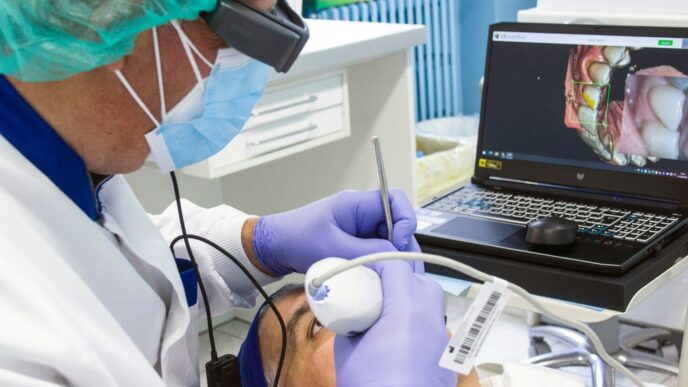You know, healthcare is changing, and a lot of that has to do with computers and software. We’re talking about how companies provide software to doctors and hospitals over the internet, instead of them buying and installing it all themselves. This approach, known as software as a service in healthcare, is really shaking things up. It’s making things easier, more connected, and hopefully, better for everyone involved, especially patients. Let’s take a look at what this means for how we get medical care.
Key Takeaways
- Software as a Service (SaaS) in healthcare means using cloud-based applications accessed online, moving away from traditional installed software. This makes it more flexible and accessible.
- SaaS is changing how patient information is managed, making Electronic Health Records (EHRs) more useful and administrative tasks smoother, freeing up staff time.
- Patients benefit directly through better communication tools, personalized care plans based on data, and remote monitoring, making healthcare more convenient.
- Security and following rules are a big deal. SaaS in healthcare focuses on protecting sensitive patient data and meeting strict regulations like HIPAA.
- Financially, SaaS is often more affordable upfront because it uses a subscription model, shifting costs from big one-time purchases to ongoing operational expenses.
Understanding Software as a Service in Healthcare
Defining SaaS in the Healthcare Context
So, what exactly is Software as a Service, or SaaS, when we talk about healthcare? Think of it like renting software instead of buying it outright. Instead of installing programs on every computer in your clinic or hospital, you access them over the internet. This cloud-based approach means you can get to your tools from pretty much anywhere, as long as you have a connection. It’s a big change from the old days of buying software licenses and dealing with all the installation headaches.
The Shift From Traditional Software Models
Remember when getting new software meant buying a big box, installing it on a server, and then hoping it wouldn’t break? That’s the traditional model. It often involved huge upfront costs for licenses and hardware, plus ongoing fees for updates and maintenance. SaaS flips that. It’s more like a subscription service. You pay a regular fee, and the provider handles all the updates, security, and keeping the lights on. This makes it easier for smaller practices to get access to advanced tools without breaking the bank. It’s a move towards more flexible and accessible technology for everyone in the medical field. This shift is a key part of how cloud computing is changing the industry.
Core Benefits of SaaS Adoption
Why are so many healthcare places jumping on the SaaS bandwagon? Well, there are some pretty solid reasons:
- Cost Savings: You avoid those massive upfront costs. Instead, you pay as you go, which is much easier on the budget. This means more money can go directly into patient care.
- Scalability: Need more users or features? With SaaS, it’s usually just a matter of adjusting your subscription. If you need less, you can scale back too. It grows with you.
- Automatic Updates: No more waiting for IT to install the latest version. SaaS providers push updates automatically, so you’re always working with the most current and secure software.
- Accessibility: Access your systems from anywhere with an internet connection. This is a game-changer for remote work and collaboration among different care teams.
Transforming Patient Care Through SaaS Solutions
Software as a Service (SaaS) is really changing how we do things in healthcare, making patient care better and more efficient. It’s not just about new gadgets; it’s about smarter ways to manage information and connect with people.
Revolutionizing Electronic Health Records
Remember those stacks of paper charts? SaaS has helped move us past that. Electronic Health Records (EHRs) powered by SaaS are now much easier to access and keep updated. This means doctors and nurses can get to important patient info right when they need it, leading to quicker, more informed decisions. It’s like having a patient’s whole history at your fingertips, instantly.
Optimizing Administrative Workflows
Let’s be honest, healthcare has a lot of paperwork. SaaS is stepping in to clean up a lot of the administrative mess. Things like scheduling appointments, managing patient check-ins, and even handling billing and insurance claims are getting simpler. These systems can automate a lot of the repetitive tasks, freeing up staff to focus on what really matters: the patients. Think about how much time is saved when appointment reminders go out automatically or when billing errors are caught early by smart software.
Enhancing Patient Engagement and Communication
SaaS is also making it easier for patients to connect with their healthcare providers. Telemedicine platforms, for example, let people have virtual visits from their homes, which is a huge help for those who live far away or have trouble getting around. Plus, many SaaS tools offer patient portals or apps where people can see their test results, schedule appointments, or even get reminders to take their medication. This keeps patients more involved in their own health journey.
Leveraging SaaS for Personalized Patient Journeys
Think about how you like to get things done. You probably don’t want the same exact experience as everyone else, right? Healthcare is starting to catch up to that idea. Software as a Service (SaaS) is really helping make patient care more about the individual.
Tailoring Care Plans with Data-Driven Insights
SaaS platforms can pull together a lot of information about a patient – things like their medical history, test results, even lifestyle habits if they share them. This data helps doctors and nurses see the whole picture. Instead of a one-size-fits-all approach, they can create care plans that are specifically designed for you. This means treatments and advice are more likely to work because they’re based on your unique situation. It’s like getting a custom-made suit instead of one off the rack.
Enabling Remote Patient Monitoring
Remember when you had to go to the doctor for every little check-up? SaaS is changing that. With remote monitoring tools, devices you wear or use at home can send your health information straight to your care team. This could be blood pressure readings, glucose levels, or even just activity tracking. If something looks off, they can spot it early and reach out before it becomes a bigger problem. This is super helpful for people with ongoing conditions or those who live far from their doctor’s office.
Here’s a quick look at what can be monitored:
- Heart rate
- Blood sugar levels
- Oxygen saturation
- Activity and sleep patterns
- Weight
Improving Accessibility Through Virtual Consultations
SaaS has also made it much easier to talk to your doctor without leaving your house. Virtual consultations, or telemedicine, are now a common thing. You can schedule an appointment and connect with your healthcare provider through a video call. This saves time, reduces travel stress, and makes it possible to get medical advice even if you’re stuck at home or can’t easily get around. It really opens up access to care for a lot more people.
Ensuring Data Security and Regulatory Compliance

When we talk about healthcare software, especially the kind that handles patient information, security and following the rules are super important. It’s not just about making things work; it’s about making sure sensitive data stays safe and that everyone is playing by the book. SaaS providers know this, and they build their systems with these things in mind from the start.
Robust Security Measures for Sensitive Information
Think about all the personal health details out there. It’s a lot, and it needs serious protection. SaaS platforms use a bunch of tools to keep this data locked down. You’ll often find things like:
- Encryption: This scrambles the data so even if someone got their hands on it, they couldn’t read it without the right key. It’s like putting your information in a secret code.
- Multi-Factor Authentication (MFA): This is more than just a password. It usually means you need a password plus something else, like a code sent to your phone, to log in. It makes it much harder for unauthorized people to get in.
- Access Controls: Not everyone needs to see everything. These systems let administrators decide who can see what information based on their job. So, a billing person might see financial data, but not detailed medical notes, for example.
- Regular Backups: Stuff happens, like system crashes or cyberattacks. Having automatic backups stored safely means that even if the worst occurs, the data can be recovered.
Adherence to Healthcare Regulations
Healthcare is a heavily regulated field, and for good reason. Laws like HIPAA in the United States and GDPR in Europe set strict rules for how patient data must be handled. SaaS companies that work with healthcare providers have to design their services to meet these requirements. This means they have to be really careful about:
- Data Storage: Where is the data kept, and is it in a location that meets regulatory standards?
- Data Transmission: How is data sent between systems, and is it protected during transit?
- Audit Trails: Keeping records of who accessed what data and when is often a legal requirement.
- Breach Notification: Having clear plans in place for what to do if a data breach does happen.
Building Trust Through Secure Implementations
Ultimately, all these security measures and regulatory checks are about building trust. Patients need to feel confident that their most private information is safe with their doctors and the technology those doctors use. When healthcare organizations choose SaaS solutions that have a strong track record in security and compliance, it shows their patients that they are serious about protecting their data. It’s a big part of why SaaS is becoming such a go-to option in healthcare today.
The Financial Advantages of SaaS in Healthcare
Let’s talk money. For a long time, getting new software for a clinic or hospital meant a massive upfront payment. You’d buy licenses, maybe new hardware, and then pay for ongoing maintenance. It was a big chunk of change, often called capital expenditure. But with Software as a Service (SaaS), things have really changed. It’s more like a subscription service you’re used to for streaming movies or music.
Reducing Upfront Costs with Subscription Models
This subscription approach is a game-changer. Instead of dropping a huge sum all at once, you pay a regular fee, usually monthly or yearly. This makes advanced technology much more reachable, especially for smaller practices or those just starting out. You get access to powerful tools without needing a massive budget to begin with. It’s a much gentler way to get your foot in the door with modern systems. This shift means you can get going with solutions that improve patient care without breaking the bank. Many organizations see significant returns on investment, often within a few years, thanks to these cost savings and operational improvements [7397].
Shifting from Capital to Operational Expenditure
So, instead of spending big on equipment and licenses (capital expenditure), you’re spending on a service you use (operational expenditure). This is often easier to manage from a budgeting perspective. It also means the software provider handles updates and maintenance, which saves your IT team a lot of headaches and your organization a lot of money. Think about it: no more surprise bills for server upgrades or emergency software patches. It’s a more predictable financial model.
Making Advanced Technology More Accessible
Because the initial investment is lower and the costs are spread out, SaaS makes sophisticated healthcare technology available to a wider range of providers. This includes things like advanced electronic health record systems, patient engagement platforms, and data analytics tools. It levels the playing field a bit, allowing more practices to adopt tools that can truly transform how they operate and care for patients. This accessibility is key to modernizing healthcare across the board.
Navigating Challenges and Future Trends
So, we’ve talked a lot about the good stuff with SaaS in healthcare, right? But it’s not all sunshine and rainbows. There are definitely some hurdles to jump over, and it’s good to know what’s coming down the pipeline.
Addressing Concerns About Data Privacy and Interoperability
One of the biggest worries people have is keeping patient data super safe. It’s sensitive stuff, after all. While SaaS providers are getting better at locking things down, making sure everything is secure and follows all the rules, like HIPAA, is still a big deal. Another headache is making sure different software systems can actually talk to each other. Imagine trying to get your doctor’s office software to share info with the lab’s system – it’s not always easy. This is where things like standardized data formats become really important. We need systems that can play nice together so information flows smoothly, without a bunch of manual data entry or lost details. Getting these systems to communicate effectively is key to truly connected care.
The Role of AI and Machine Learning in SaaS
Now, this is where things get really interesting. Artificial intelligence (AI) and machine learning are starting to pop up everywhere, and healthcare SaaS is no exception. Think about it: AI can sift through tons of patient data way faster than any human could, spotting patterns that might help predict illnesses or suggest the best treatment. It’s not about replacing doctors, but giving them smarter tools. For example, AI can help analyze medical images, making diagnoses quicker and more accurate. This is changing how we think about SaaS in the life sciences, moving it from just a tool to something more intelligent. We’re seeing AI automate repetitive tasks, freeing up healthcare pros to focus on patients.
The Evolving Landscape of Digital Health Platforms
What’s next? Well, the whole digital health scene is changing fast. We’re moving towards more connected care, where your wearable device might be sending data straight to your doctor’s SaaS platform. Telehealth is also getting a big boost from these platforms, making it easier for people to see a doctor without leaving their homes. It’s all about making healthcare more accessible and, hopefully, more personalized. The goal is to have these digital platforms work together, creating a smoother experience for everyone involved, from the patient to the provider. It’s a big shift, but one that promises to make healthcare delivery much better.
The Future Impact of SaaS on Healthcare Delivery
So, what’s next for Software as a Service in healthcare? It’s pretty clear that this isn’t just a passing trend. We’re looking at a future where SaaS plays an even bigger role in how we get medical help.
Driving Better Clinical Outcomes with AI-Augmented Systems
Think about AI and machine learning. These aren’t just buzzwords anymore; they’re becoming real tools in healthcare, and SaaS is the perfect way to get them into doctors’ hands. SaaS platforms can crunch huge amounts of patient data – things like genetic info, lifestyle habits, and past medical history – way faster than a person ever could. This helps spot patterns that might lead to diseases before they become serious problems. It’s like having a super-smart assistant that can flag potential issues, allowing doctors to step in early.
- Predictive analytics: Spotting patients at high risk for certain conditions.
- Personalized treatment: Suggesting the best course of action based on a patient’s unique profile.
- Diagnostic support: Helping doctors interpret complex scans or test results more accurately.
This integration means we’re moving towards care that’s not just reactive, but truly proactive.
Redefining the Patient-Provider Relationship
Remember when seeing a doctor meant a long wait in a stuffy room? SaaS is changing that. Telemedicine, powered by cloud software, makes it easier than ever to connect with your doctor from your couch. This isn’t just about convenience; it means people in rural areas or those with mobility issues can get the care they need without the hassle. Plus, apps that let you track your own health data and share it easily with your doctor build a stronger partnership. You become more involved in your own health journey.
Expanding Access to High-Quality Care
One of the biggest promises of SaaS is making good healthcare available to more people. By reducing the need for expensive on-site hardware and complex installations, SaaS makes advanced tools affordable for smaller clinics and practices. This levels the playing field. It means that whether you live in a big city or a small town, you’re more likely to have access to the same quality of care. The cloud breaks down geographical barriers, making healthcare more equitable for everyone.
Looking Ahead
So, what does all this mean for the future of how we get healthcare? Basically, Software as a Service is changing things in a big way. It’s making it easier for doctors and nurses to do their jobs, which means they have more time to focus on you. Plus, it’s making healthcare more accessible, whether that’s through virtual visits or just better ways to manage your health information. While there are still some bumps in the road, like making sure everything is secure and easy for everyone to use, the trend is clear. SaaS is helping to build a healthcare system that’s more efficient, more connected, and ultimately, better for all of us.
Frequently Asked Questions
What exactly is SaaS in healthcare?
SaaS stands for Software as a Service. Think of it like renting software instead of buying it. In healthcare, this means doctors and hospitals use special computer programs over the internet, usually paying a monthly fee. It’s like using an app on your phone, but for managing patient info, appointments, and other important tasks.
How does SaaS help doctors and patients?
SaaS can make things much smoother. For doctors, it helps keep patient records organized and easy to access, speeds up tasks like billing, and allows them to communicate better with patients. For patients, it can mean easier appointment scheduling, quicker access to their health information, and even talking to their doctor from home.
Is my personal health information safe with SaaS?
Yes, good SaaS companies take patient privacy very seriously. They use strong security measures, like special codes and locks, to protect sensitive health data. They also follow strict rules, like HIPAA, to make sure your information is kept safe and private.
Is SaaS expensive for hospitals?
Not really! Instead of paying a huge amount upfront for software and computers, hospitals pay a smaller, regular fee, like a subscription. This makes powerful technology more affordable and easier to manage, especially for smaller clinics or practices.
Can SaaS help doctors give more personalized care?
Absolutely! SaaS tools can gather and analyze a lot of patient information. This helps doctors understand each person’s unique health needs better. They can then create care plans that are just right for that individual and even keep an eye on them from afar using special devices.
What’s the future of SaaS in healthcare?
The future looks bright! We’ll likely see even smarter SaaS tools using things like Artificial Intelligence (AI) to help doctors make better decisions. It will also make it easier for patients to connect with their doctors remotely, making healthcare more convenient and accessible for everyone.














